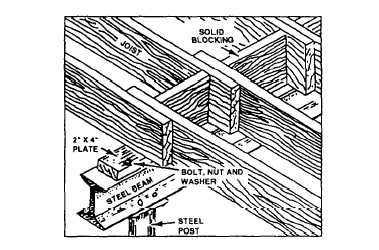Figure 1-16.—Header joist.
placed in sections. Solid girders must be measured and
cut so that the ends fall over the center of a post. Built-up
girders should be placed so their outside joints fall over
the posts (fig. 1-13).
FLOOR JOISTS
In platform framing, one end of the floor joist
rests directly on the sill plate of the exterior
foundation wall or on the top plate of a framed outside
wall. The bearing should be at least 1 1/2 inches. The
opposite end of the joist laps over or butts into an
interior girder or wall. The size of joist material (2 by
6, 2 by 10, 2 by 12, and so forth) must be chosen with
consideration for the span and the amount of load to
be carried. The foundation plan usually specifies the
joist size, the spacing between joists, and what
direction the joists should travel.
The usual spacing of floor joists is 16 inches OC.
Floor joists are supported and held in position over
exterior walls by header joists or by solid blocking
between the joists. The header-joist system is used most
often.
Header
Header joists run along the outside walls. Three 16d
nails are driven through the header joists into the ends
of the common joists, as shown in figure 1-16. The
header and joists are toenailed to the sill with 16d nails.
The header joists prevent the common joists from
Figure 1-17.—Lapped joists.
rolling or tipping. They also help support the wall above
and fill in the spaces between the common joists.
Lapped
Joists are often lapped over a girder running down
the center of a building. The lapped ends of the joists
may also be supported by an interior foundation or
framed wall. It is standard procedure to lap joists the full
width of the girder or wall. The minimum lap should be
4 inches. Figure 1-17 shows lapped joists resting on a
steel girder. A 2- by 4-inch plate has been bolted to the
top of a steel beam. The joists are toenailed into the plate.
Solid blocking may be installed between the lapped ends
after all the joists have been nailed down. Another
system is to put in the blocks at the time the joists are
placed.
Double
Joists should be doubled under partitions running in
the same direction as the joists. Some walls have water
pipes, vent stacks, or heating ducts coming up from the
basement or the floor below. Place bridging between
double joists to allow space for these purposes
(fig. 1-18).
Cantilevered
Cantilevered joists are used when a floor or balcony
of a building projects past the wall below, as shown in
figure 1-19. A header piece is nailed to the ends of the
1-8




